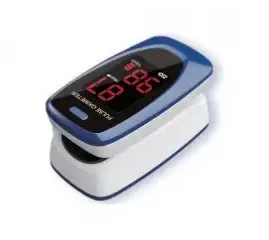Your cart is currently empty!

Pulse oximeter, saturation, respiratory trainer – a strategy to fight coronavirus
Pulse oximeter in COVID-19
Until recently, pulse oximeters were mainly purchased by people with chronic lung diseases and professional athletes. The pandemic has caused Poles to reach for pulse oximeters prophylactically. Following the health minister’s announcement that some coronavirus-infected patients who are asymptomatic or mildly infected will receive a pulse oximeter, the device has become as recognizable and desirable as ever in the Polish market. What would be the basis for its inclusion in the COVID-19 combat strategy? The devices are to be given to those who test positive for coronavirus, as indicated by family doctors. The assumption is that the pulse oximeter can help patients infected with COVID-19 by indicating quite precisely when they should go to the hospital. Some people with symptoms go through the disease mildly, but sometimes their health deteriorates suddenly, and help for those previously in home quarantine comes too late. The pulse oximeter is supposed to instantly indicate the limit beyond which immediate hospitalization is required.
Saturation measurement
Saturation is an indicator of the saturation of peripheral blood hemoglobin with oxygen, when it drops, we usually begin to feel shortness of breath. Saturation level testing is non-invasive, safe and often used by doctors, for monitoring the patient’s condition during and after various procedures or surgeries. Below-normal saturation is a result of less than 90% and usually indicates severe respiratory failure. Note that even if the saturation is high (the blood is adequately oxygenated), the oxygen value at the cellular level may be low. The saturation test does not refer to oxygen metabolism in cells. For testing blood oxygen saturation at home, it is the pulse oximeter that works perfectly.
Pulse oximeter, or what?

Pulse oximeter is a device designed for non-invasive measurement of blood saturation. The device is most often applied to the patient’s finger, although models applied to, for example, an earlobe or toe are also available.
For very young children and newborns, pulse oximeters are usually worn on the wrist or foot. Stationary pulse oximeters are primarily used in hospitals, nursing homes and various types of medical facilities. It features more functions so that pressure or breathing measurements can also be taken. In contrast, napalm pulse oximeters have a sensor that is worn on the finger of the person being measured. It is designed for use outside the hospital, so a person who is aware of its use can take measurements at any time – on the go, at work. In addition to indicating the blood oxygenation level as a percentage, even the simplest pulse oximeter also shows the heart rate (value in beats per minute).
How does the pulse oximeter work ?
The mathematical formula uses Lambert Beer’s law, which is the relationship of the absorption characteristics of the spectrum of deoxygenated hemoglobin and oxyhemoglobin, which is close to the infrared zones. Photoelectric oxyhemoglobin control technology is in accordance with the ability of scanning and recording technology. It adopts according to scanning potential pulses and recording technology, so that two beams of different wavelengths of light (660 nm red and 905 nm near infrared), can focus on the human nail tip with a sensor clamped on the finger. The measured signal received by the photosensitive element, will be shown on the display thanks to the process taking place in the electronic circuits, and the microprocessor will show the result on the display. The scheme of operation is contained in a red and infrared emission tube and a receiving tube.
Only proven medical equipment
It is difficult today to find a certified pulse oximeter at an unbeatable price. The Polish market has been flooded with relatively cheap products from China, which medical stores or pharmacies cannot afford to sell, through lack of proper documentation to guarantee its quality. It is the qualification of the equipment as a medical device that is the basic condition for expecting a reliable measurement. Inaccurate measurements can also be the share of reputable equipment, for reasons beyond their control. Incorrect results include both mundane causes, such as polished, fungus-ridden, artificial or thickly lacquered nails. Also movement of the patient during the examination or strong light at the examination site. The reading will also be unreliable in people with severe hypotension, vasospasm, severe anemia and hypothermia, and the result will also be disturbed by venous pulsations or intravascular dyes.
Breathing exercise device

Breathing trainer, is a training device that strengthens respiratory muscles.
Respiratory fitness is especially important for people with lung diseases such as asthma, such an assistive device is also extremely helpful for patients who have undergone abdominal or thoracic surgery and require post-operative physiotherapy, and are also supportive for people after serious infections in the lungs. The colored balls provide a visual indication of how their breathing muscles are working, encouraging progress through slow, sustained maximum inhalation. The patient pushes air through a mouthpiece connected to a structure with three chambers, each containing a color-coded ball with the minimum flow rate printed on the outside of each chamber. As the patient takes deep breaths to push air into the exercise device, he or she lifts the color-coded balls at an airflow rate of 600 to 1,200 cc per second. When all three beads peak, it means the patient has reached the optimal 1200 cc.



